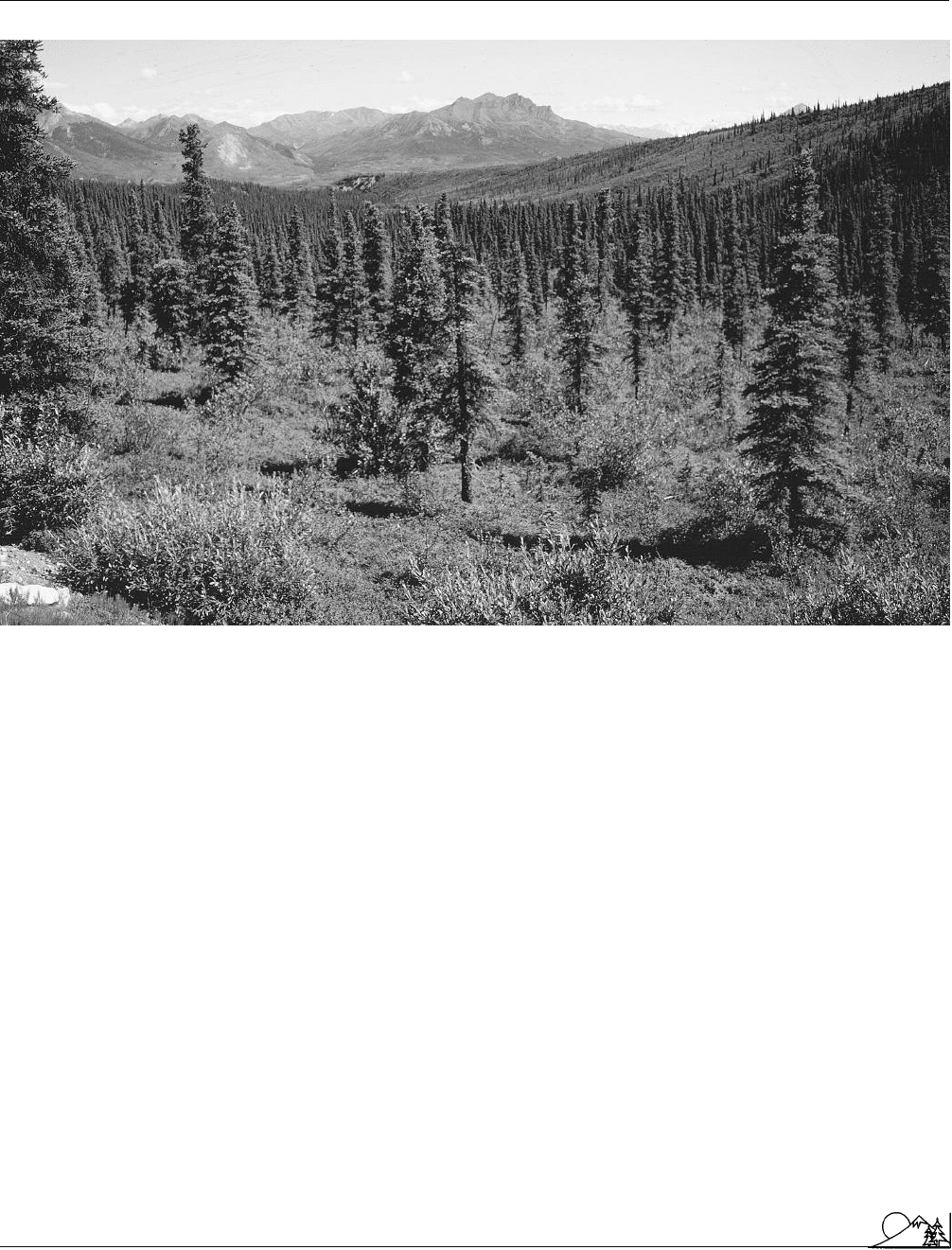Environmental Encyclopedia
Подождите немного. Документ загружается.


T
Taiga
Taiga is a generic term for a type of conifer-dominated
boreal forest found in northern environments. The word
was first used to describe dense forests of spruce (especially
Picea abies) in northern Russia. It has been extended to refer
to boreal forests of similar structure in North America but
dominated by other conifer
species
(especially Picea mariana
and Picea glauca). Broad-leafed tree species are uncommon
in taiga, although species of poplar (Populus spp.) and birch
(Betula spp.) are present. Taiga environments are character-
ized by cool and short growing seasons. Plant roots can only
exploit a superficial layer of seasonally thawed ground, the
active layer, situated above permanently frozen substrate, or
permafrost
.
Tailings
Tailings are produced when metallic ores are ground into a
fine powder to free the metal-bearing mineral. Its maximum
particle size of about 0.08 in (2 mm) is small enough to
retain water and support plant growth. Fine dust is one
potential hazard, especially if trapped in the lungs of miners.
The greatest revegetation difficulties come from metals in
lethal concentrations and deficiencies of critical nutrients,
especially
nitrogen
and
phosphorus
. Some old tailings have
remained barren for many years, with consequent high
ero-
sion
rates. However, some metalophytes are able to survive
on these wastes. Curiously, some plants have populations
which can also survive on these tailings.
Tailings pond
Refers to the water stored on-site to wash ore and receive
waste
tailings
as a residue. This provides both a water supply
and a
sediment
trap. Two serious environmental problems
ensue. The water leaches out metals and other dangerous
elements that were formerly trapped underground in a reduc-
1377
ing (non-oxidizing)
environment
; acidic wastes amplify the
leaching
. And though usually stable, some
dams
have burst
during flood stages, unleashing a torrent of toxic materials
and posing a combined hazard of mudflow and
flooding
.
Takings
The term “takings” refers to the practice of taking, or other-
wise restricting the use of, private property through the
governmental power of eminent domain, environmental reg-
ulation, or other restrictions. The power of eminent do-
main—and the property owner’s right to compensation—is
stated in the Bill of Rights (Fifth Amendment to the U.S.
Constitution): “nor shall private property be taken for public
use, without just compensation.” Likewise, the Fourteenth
Amendment stipulates that no state may “deprive any person
of life, liberty, or property, without due process of law; nor
deny to any person within its jurisdiction the equal protection
of the laws.”
Critics of environmental regulation contend that gov-
ernment cannot constitutionally interfere with a property
owner’s freedom to do as he or she wishes with his or
her own property without compensating the owner. For
example, a farmer who wishes to extend or improve his land
by draining a swamp or other wetland cannot be forbidden
to do so without adequate compensation. A rancher who is
forbidden by law to shoot or trap
wolves
that threaten his
cattle can claim compensation for livestock losses due to
wolf predation. To “take” or otherwise regulate or restrict
the use of their property without full and fair compensation
would constitute a violation of their constitutionally guaran-
teed rights under the Fifth and Fourteenth Amendments.
Many environmentalists maintain that the high cost
of such compensation would mean the effective end of many
environmental regulations regarding
wetlands
, woodlands,
and other habitats on private property. They contend that
the Constitution does not construe the concept of “takings”
as broadly as their critics do. There have long been restric-

Environmental Encyclopedia 3
Tall stacks
White spruce-willow taiga in Alaska. (Photograph by Charlie Ott. Photo Researchers Inc. Reproduced by permission.)
tions on what one may do to or with his or her property.
There are, for example, restrictions on erecting billboards on
private property along public highways.
Automobile
salvage
yards can be required to erect walls to shut out the unsightly
view. In neither case is the owner to be compensated for
loss, cost, or inconvenience. In these instances, the public
interest in avoiding eyesores overrides the private interests
of the property owners. So too, environmentalists contend,
does the public interest in a clean, safe, and sustainable
natural
environment
empower the federal, state, or local
government to enact and enforce laws restricting what prop-
erty owners may do with or to
wildlife
and the
habitat
that sustains them.
The legal and political battles over “takings” continues
to be waged in the courts of law and public opinion. Some
critics of environmental protection (most notably, libertari-
ans associated with the Cato Institute) contend that the
Constitution does not go far enough in guaranteeing the
protection of private property rights and should therefore
be further amended. Some environmentalists claim that the
Constitution should, on the contrary, be amended to extend
protection to animals, ecosystems, and
future generations
.
1378
It seems plausible to predict that these battles will be waged
well into the twenty-first century.
[Terence Ball]
R
ESOURCES
B
OOKS
Epstein, R. A. Takings: Private Property and the Power of Eminent Domain.
Cambridge, MA: Harvard University Press, 1985.
Tall stacks
The waste gases that escape from factories or
power plants
running on
fossil fuels
typically contain a variety of pollut-
ants, including
carbon monoxide
, particulates,
nitrogen
oxides
, and sulfur. The first of these pollutants,
carbon
monoxide, tends to dispense rapidly once it is released to
the
atmosphere
and seldom poses a serious threat to human
health or the
environment
. The same cannot be said of the
last three categories of pollutants, all of which pose a threat
to the well-being of plants, humans, and other animals.

Environmental Encyclopedia 3
Talloires Declaration
During the 1960s, humans became increasingly aware
of the range of hazards, posed by pollutants escaping from
smokestacks. One of the most common events of the time
was for residents in the area immediately adjacent to a factory
or plant to find their homes and cars covered with fine dust
from time to time. They soon learned that the dust was
fly
ash
released from the nearby smokestacks. Particulates (fine
particles of unburned carbon) also tend to settle out fairly
rapidly and cover objects with a fine black powder.
It was clear that visible pollutants, such as fly ash and
particulates, offered a hint that invisible pollutants, such as
oxides of
nitrogen
and sulfur, were also accumulating in
areas close to factories and power plants. As the health
hazards of these pollutants became better-known, efforts to
bring them under control increased.
Certain technical methods of
air pollution
control—
electrostatic precipitation and scrubbing, for example—were
reasonably well-known. However, many industries and utili-
ties preferred not to make the significant financial investment
needed to install these technologies. Instead, they proposed
a simpler and less expensive solution: the construction of
taller smokestacks.
The argument was that, with taller smokestacks, pol-
lutants would be carried higher into the atmosphere. They
would then have more time and space to disperse. Residents
close to the plants and factories would be spared the fallout
from the smokestacks. The “tall stack” solution met the
requirements of the 1970
Clean Air Act
as a “last-ditch
alternative” to gas-cleaning technologies.
As a result, companies began building taller and taller
smokestacks. The average stack height increased from about
200 ft (61 m) in 1956 to over 500 ft (152 m) in 1978. The
tallest stack in the United States in 1956 was under 600 ft
(182 m) tall, but a decade later, some stacks were more than
1,000 ft (305 m) high.
At first, this effort appeared to be a satisfactory way of
dealing with air pollutants. The concentration of particulates
and oxides of nitrogen and sulfur close to plants did indeed,
decrease after the installation of tall stacks.
But new problems soon began to appear, the most
serious of which was
acid deposition
. The longer oxides
of sulfur and nitrogen remain in the air, the more likely they
are to be oxidized to other forms, sulfur trioxide and nitrogen
dioxide. These oxides, in turn, have the tendency to react
with water droplets in the atmosphere forming sulfuric and
nitric acids, respectively. These acids eventually fall back to
earth as rain, snow, or some other form of precipitation.
When they reach the ground, they then have the potential
to damage plants, buildings, bridges, and other objects.
The mechanism by which stack gases are transported in
the atmosphere is still not completely understood. Yet it is
now clear that when they are emitted high enough into the
1379
atmosphere, they can be carried hundreds or thousands of
miles away by prevailing winds. The very method that reduces
the threat of air pollutants for communities near a factory or
power plant, therefore, also increases the risk for communities
farther away. See also Acid rain; Air quality; Criteria pollutant;
Emission; Scrubbers; Smoke; Sulfur dioxide
[David E. Newton]
R
ESOURCES
P
ERIODICALS
“The Dirtiest Half-Dozen.” Time 139 (June 8, 1992): 31.
Harris, J. “How to Sell Smoke.” Forbes 145 (June 11, 1990): 204–205.
“New Clues to What An Incinerator Spews.” Science News 140 (September
21, 1991): 189.
Talloires Declaration
The Talloires Declaration was created in October 1990 in
Talloires, France. Jean Mayer, then president of Tufts Uni-
versity in Boston, called together 22 other university presi-
dents and chancellors from universities throughout the world
in order to express their concerns regarding the state of the
world as well as prepare a document that identified key
environmental actions that institutions of higher learning
must take to prepare.
According to their organization, University Leaders
for a Sustainable Future (ULSF), “Recognizing the shortage
of specialists in environmental management and related
fields, as well as the lack of comprehension by professionals
in all fields of their effect on the
environment
and public
health, this gathering defined the role of the university in
the following way: “Universities educate most of the people
who develop and manage society’s institutions. For this rea-
son, universities bear profound responsibilities to increase
the awareness, knowledge, technologies, and tools to create
an environmentally sustainable future.’”
The actions outlined are listed as follows:
O
increase awareness of environmentally
sustainable devel-
opment
O
create an institutional culture of sustainability
O
educate for environmentally responsible citizenship
O
foster environmental literacy for all
O
practice institutional ecology
O
involve all stakeholders
O
collaborate for interdisciplinary approaches
O
enhance capacity of primary and secondary schools
O
broaden service outreach nationally and internationally
O
maintain the movement

Environmental Encyclopedia 3
Arthur G. Tansley
By May 2002, the declaration had been signed by 288
institutions, including 17 in Africa; 99 in Canada and the
United States; 108 in Latin America and the Caribbean; 33
in Asia, the Middle East, and the South Pacific; and 31 in
Europe and Russia. ULSF has reported that the document
has provided inspiration for other similar official declarations
in locations throughout the world, including Halifax, Nova
Scotia, Canada; and, Kyoto, Japan—home of the monumen-
tal
Kyoto Treaty
.
Programs have been developed at universities and col-
leges throughout the United States. One exemplary program
was established at Ball State University in Muncie, Indiana.
In an introduction to the Ball State plan, associate professor
James Elfin of the Ball State Department of Natural Re-
sources and Environmental Management, stated that, “If
colleges and universities are leaders in the quest for knowl-
edge, why can’t they be leaders on the path to a sustainable
future?...Academic institutions are regarded—rightly or
wrongly—as vanguards for what is possible and encuring.
They are perceived to be on the forefront of what society
can attain. As an institution, the university endures over a
long span of time—if successful, it can be imagined to last
forever. In an earlier edition of The Declaration...architect
William McDonough was asked how long sustainability will
take. His reply: “It will take forever. That’s the point.’” Ball
State outlined an extensive plan with a list of Action Items,
practical ways in which to implement a “greening” of the
campus.
The list of 10 items are as follows:
O
audits (three of them: one of campus environment, another
of faculty expertise, and a third of needs of K–12 schools
across the state of Indiana)
O
campus bikeway system
O
developing an
environmental education
resource center
(in the meantime, a separate effort on campus has resulted
in the creation of a field station and environmental educa-
tion center, FSEEC)
O
green issues awareness (or, “green facts” that would be
distributed via various media on and off campus)
O
retrofit or reconfiguration of the Central (District) Heat-
ing Plant
O
adopting hybrid electric (or other energy-efficient) vehicles
for the campus motor pool
O
campus-wide
recycling
program (one has existed, but is
not effectively run nor fully integrated with all campus
operations)
O
sustainability trunk show (to spread the word to larger
publics outside the university community)
1380
O
incorporation of sustainability within the university core
curriculum (or, general education program that is required
by all students)
[Jane E. Spear]
R
ESOURCES
O
THER
Environmental News Network. The Worldwatch Report: Campus Environ-
mental Programs Spur Action. June 1, 1998 [cited June 2002]. <http://
www.enn.com/features>.
Safe Climate. University of Buffalo: How to Shrink the University’s Carbon
Footprint While Reducing the Cost of Education. 1996 [cited June 2002].
<http://www.safeclimate.net/index>.
O
RGANIZATIONS
University Leaders for a Sustainable Future, 2100 “L” Street, NW,
Washington, DC USA, 20037, 202-778-6133, Fax: 202-778-6138,
<http://www.ulsf.org>
Arthur G. Tansley (1871 – 1951)
British botanist
Arthur G. Tansley was a highly influential British botanist
and ecologist. He was educated at University College, Lon-
don, and Trinity College of Cambridge University. He
taught at University College until 1906, and then moved to
Cambridge. In 1927, He became a Professor of Botany at
Oxford, and he retired as a Professor Emeritus in 1937.
Much of his retirement was spent working for the
conserva-
tion
of
nature
in Britain, largely by public advocacy and by
working with the
Nature Conservancy
, of which he was
the first Chairman.
In 1902, Tansley founded the influential botanical
journal, New Phytologist, and was its editor for thirty years.
He was a founder of the British Ecological Society in 1913,
and was the editor of its key periodical, the Journal of Ecology,
for twenty years. Tansley’s classic book, The British Islands
and Their Vegetation, was published in 1939.
Tansley was highly influential in the development of
the field of ecology. He was the first person to use the word
“ecosystem” to describe a basic unit of nature. He coined
the word as a reduction of the phrase “ecological system”
(the word “system” was borrowed from its prevalent use at
the time in the field of physics). The new word was initially
used at a conference at Ithaca, New York, in 1929. It was
first published in 1935 in a highly influential paper in which
Tansley discussed and clarified key terms and concepts in
ecology. His ideas about “systems” were important in helping
ecologists to understand that organisms and their communi-
ties are profoundly influenced by many non-living environ-
mental factors, and vice versa (i.e., organisms and their com-
munities also influence environmental factors). Much of the

Environmental Encyclopedia 3
Tar sands
power of the
ecosystem
concept is inherent in its consider-
ation of the complex, often unpredictable behavior of sys-
tems. The subsequent emergence of the field of systems
ecology drew heavily on physics, mathematics, and computer
science, as well as the more traditional ecological disciplines
of plant and animal ecology. Prior to Tansley’s ideas about
ecosystems, ecologists mostly studied populations of plant
and animal
species
, or their communities, but with relatively
little regard for the influence of and interaction with environ-
mental factors.
Modern ecologists now consider ecosystems as con-
sisting of all of the biotic (plants, animals, and
microorgan-
isms
) and abiotic (
climate
,
soil
, and other non-living envi-
ronmental factors) elements of a specified area or volume.
As such, an ecosystem can be relatively small (e.g., contained
within a
clod
of earth or an aquarium) or as large as the
entire
biosphere
of the Earth. Moreover, the state of an
ecosystem at any point in time (for example, during
succes-
sion
following disturbance) represents the present balance
between biological and abiotic influences.
Many ecologists also believe that ecosystems do not
just consist of the sum of the qualities of their individual
parts. Rather, there are also “emergent” properties that can-
not be easily predicted, but may nevertheless be extremely
important in the
stability
and
resilience
of the ecosystem.
For example, some particularly important species, known
as
keystone species
, may have a highly disproportionate
influence on the integrity of their ecosystem, which could
not be predicted based only on their relative contribution of
biomass
or productivity. Some top predators, for instance,
play a key role in setting the structure of their entire food
web, while certain microorganisms (such as
nitrogen
fixers)
have an inordinate influence on overall productivity. Inter-
estingly, in his 1935 paper, Tansley objected to some of the
original, emerging ideas about holism in ecology; neverthe-
less, as evidence of emergent properties has accumulated,
holistic ideas have taken root in the theory and practice of
ecology.
Tansley is also known for his criticisms of the views
of the influential American ecologist,
Frederic Clements
(1874-1945). Clements believed that plant communities
were highly integrated and “organismic” in their qualities,
and not merely a sum of their individual species. He also
suggested that succession, or the process of development of
plant communities after disturbance, should proceed to a
highly predictable and stable
climax
community determined
by regional conditions, particularly climate. This view was
heavily criticized by another American ecologist,
Henry
Gleason
(1882-1975), who argued that plant species re-
spond to succession and environmental gradients in an indi-
vidualistic manner, rather than in a strongly integrated, or
organismic way. Tansley played an important role in this
1381
debate, and favored the individualistic hypothesis as being
most realistic.
Tansley also performed important research that
showed that plant species are capable of growing over a
wider range of environmental conditions than they actually
manage to exploit in nature. His experiments showed that
competition
is the key factor restricting species to a relatively
narrow range of
habitat
conditions. This work influenced
the development of the ecological concept of the
niche
.
Modern textbooks define the fundamental niche as the in-
herent tolerance of a species to environmental extremes (such
as high and low temperatures), and the realized niche as the
range of environmental conditions that a species actually
exploits in nature, being mediated by competition.
[Bill Freedman Ph.D.]
R
ESOURCES
B
OOKS
McIntosh, R. P. The Background of Ecology: Concept and Theory. Cambridge,
UK: Cambridge University Press, 1985.
Sheail, J. Seventy-five Years in Ecology: The British Ecological Society. Oxford,
UK: The British Ecological Society, 1988.
Tansley, Arthur G., ed. The British Islands and Their Vegetation. Cambridge,
UK: Cambridge University Press, 1939.
Tansley, Arthur G. “On Competition Between Galium saxatile and Galium
sylvestre on Different Kinds of Soils.” Journal of Ecology 5 (1917): 173–179.
Tansley, Arthur G. “The Use and Abuse of Vegational Concepts and Terms.”
Ecology 16 (1935): 284–307.
Tar sands
Oil sands, formerly referred to as tar sands, are sandy sub-
strates that contain large deposits of bitumin, a kind of fossil
fuel. Bitumen is a thick, viscous, black, sticky, tar-like form
of liquid
petroleum
, but its physical consistency is compara-
ble to that of cold molasses. Oil sands occurring at or near
the surface can be mined using open-pit techniques. The
bituminous materials are then extracted by heating and the
hydrocarbons
refined and manufactured into a synthetic
petroleum product. Once the readily extractable, surface de-
posits are extracted, deeper bitumen may be mined using
steam assisted, in situ techniques that decrease viscosity and
allow the bitumen to flow so it can be pumped to the surface.
Mined oil sand typically contains 10-12% bitumen, 4-
6% water, and 80-85% mineral sand and clays. About 2.2
tons (2 tonnes) of oil sand must be processed to produce
one barrel (0.16 m
3
) of liquid petroleum. About 75% of the
bitumen present can typically be recovered from mined oil
sand. After processing, the sand waste and any unextracted
bitumen are eventually used to back-fill and contour mined-
out areas, which are then seeded with vegetation to reclaim
a stable plant cover.

Environmental Encyclopedia 3
Target species
Most economically recoverable oil sand occurs at or
fairly near the ground surface. Initially it is mined in enor-
mous open pits, using extremely large trucks and industrial
shovels, among the biggest of their kind in the world. After
the open-pit mining, remaining deposits deeper than about
250 feet (75 m) and up to 1,300 ft (400 m) or deeper are
recovered using so-called in situ, or in-site practices. Various
techniques are used for in situ extraction of bitumen and
heavy crude oil. They include the injection of steam, solvents,
or
carbon dioxide
to reduce the viscosity of the heavy fluids
so they can flow and be collected and pumped to the surface.
The largest in situ recovery plant in Alberta is located at
Cold Lake, where steam injection is used to enhance the
ability of the bitumen to flow. This allows it to be pumped
to the surface, where it is treated with liquid natural-gas
hydrocarbon condensate to reduce its viscosity. The treated
bitumen is then shipped by pipeline to a specialized refinery
complex where a relatively light synthetic petroleum is man-
ufactured from the heavy, bituminous, crude fossil fuel.
The world’s largest resources of oil sand occur in north-
ern Alberta, Canada, and in Venezuela, in northern South
America. In Alberta, there are about 54-thousand mi
2
(141-
thousand km
2
) of oil-sand deposits. This region contains a
total estimated resource of 1.6 trillion barrels (0.25 trillion
m
3
) of bitumen, of which about 311 billion barrels (49 billion
m
3
) are thought to be potentially recoverable using known
mining and extraction technologies. Once processed, this
bitumen could yield an estimated 189 billion barrels (30
billion m
3
) of synthetic petroleum.
The first pilot plant to process oil-sand bitumen was
constructed in Alberta in 1962. The first full-scale facility
was developed between 1964 and 1967, with an initial capac-
ity of 31,000 barrels per day (4.9-thousand m
3
/day). During
the 1990s, extremely large investments were made to mine
and process the oil-sand deposits of Alberta. Between 1996
and 2000, the total investment in development of this re-
source was $11 billion (Can.), and it was $4.2 billion in
2000 alone. In the year 2000, 66,000 people were directly
employed in the oil-sand industry, and the Government of
Alberta received royalties of $711 billion. In 2001, oil sands
were yielding about one-third of all the petroleum produced
in Canada, and continued investment is expected to raise
this to 50% by 2005. That would be equivalent to about
10% of the total production of petroleum in North America.
Clearly, oil sands are a key component of the resource of
liquid
fossil fuels
in North America, and a critical element
contributing to the domestic energy security on the con-
tinent.
The mining and processing of oil sands results in
important environmental impacts, although the most intense
effects are restricted to the immediate vicinity of the indus-
trial operations. For example, the development of mine sites,
1382
refineries, and pipelines results in severe direct damage to
local natural habitats. In the case of open-pit mine develop-
ment, the
soil
and other
overburden
removed from the
site are generally stockpiled for use as a top-dressing during
the
reclamation
of the pit after it is mined out. The original
surface materials are conserved for this use because they
provide a much more hospitable material for plant establish-
ment and growth than does processed oil-sand waste, which
is a highly mineral and infertile substrate. The reclamation
usually attempts to re-create a facsimile of the original con-
tours of the landscape, and is intended to establish a self-
maintaining vegetation with at least as high a level of produc-
tivity as what occurred prior to the mining. The reclamation
effort is typically designed to develop grassland, forest, or
wetland habitats, or a mixture of these. Often, the intention
is to establish vegetation dominated by native
species
of
plants. The resulting habitats may then be attractive to indig-
enous species of birds, mammals, and other animals.
The process by which bitumen is extracted from oil
sand and then manufactured into synthetic petroleum results
in some emissions of
sulfur dioxide
, a toxic gas, into the
atmosphere
. The permissible amounts of emissions are
regulated within levels intended to prevent local vegetation
damage. This is achieved by the use of scrubbing technolo-
gies that remove most sulfur dioxide from the flue gases
before they are vented to the ambient
environment
. The
mining and processing processes also require extremely large
inputs of energy to drive their processes. Industrial engineers
have been working to make the processes run more effi-
ciently, and they anticipate achieving a 45% reduction of
carbon
dioxide emissions per barrel by 2010, compared to
1990 levels. This will result in large savings in process costs,
while also reducing the emissions of carbon dioxide, an
important greenhouse gas, to the atmosphere.
[Bill Freedman Ph.D.]
R
ESOURCES
B
OOKS
Fitzgerald, J. Gold with Grit: The Alberta Oil Sands. Sidney, BC: Gray’s
Publishing, 1978.
Lyttle, R. B. Shale Oil and Tar Sands: The Promises and Pitfalls. Danbury,
CT: Impact Books, 1982.
Perrini, E. M. Oil from Shale and Tar Sands. Park Ridge, NJ: Noyes Data
Corporation, 1975.
O
THER
Government of Alberta. Oil Sands. 2002 [cited July 2002]. <http://www.en-
ergy.gov.ab.ca/com/Sands/default.htm>.
Target species
The object of a
hunting
, fishing, or collecting exercise, or
an extermination effort aimed at destroying a particular orga-

Environmental Encyclopedia 3
Tellico Dam
nism. This term is often used to describe the intended victim
of an application of
pesticide
or
herbicide
. Unfortunately,
many non-target
species
can be affected by so-called tar-
geted activities. For example, Pacific net fishermen target
the yellowfin tuna, but also snare and kill non-target species
such as
dolphins
. Pesticides applied to crops to kill insects
(the target species) can enter the
food chain/web
, become
biologically magnified, and kill non-target species such as
fish-eating birds or birds of prey. See also Biomagnification
Taylor Grazing Act (1934)
This act established federal management policy on public
grazing lands, the last major category of public lands to be
actively managed by the government. The delay in its passage
was due to a lack of interest (the lands were sometimes
referred to as “the lands no one wanted") and due to competi-
tion between the Agriculture Department and the Interior
Department over which department would administer the
new program.
The purpose of the Taylor Grazing Act was to “stop
injury to the public grazing lands...to provide for their orderly
use, improvement and development...[and] to stabilize the
livestock industry dependent on the public range.” To
achieve these purposes, the Secretary of the Interior was
authorized to establish grazing districts on the public domain
lands. The lands within these established districts were to
be classified for their potential use, with agricultural lands to
remain open for homesteading. In 1934 and 1935, President
Franklin D. Roosevelt issued Executive Orders that with-
drew all remaining public lands for such classification, an
action that essentially closed the public domain. The Secre-
tary was authorized to develop any regulations necessary to
administer these grazing districts, including the granting of
leases for up to ten years, the charging of fees, the undertak-
ing of range improvement projects, and the establishing of
cooperative agreements with grazing landholders in the area.
Another important feature of the law called upon the
Secretary of the Interior to cooperate with “local associations
of stockmen” in the administration of the grazing districts,
referred to by supporters of the law as “democracy on the
range” or “home rule on the range.” This was formalized in
the creation of local advisory boards. The law created a
Division of Grazing (renamed the Grazing Service in 1939)
to administer the law, but for a number of reasons, the
agency was ineffective. It became quite dependent on the
local advisory boards and was often cited as an example of
an agency captured by the interests it was supposed to be
controlling. In 1946, the agency merged with the General
Land Office to create the
Bureau of Land Management
.
1383
Also included in the bill was the phrase “pending final
disposal,” which implied that these grazing lands would not
necessarily be retained in federal ownership. This phrase was
included because many thought the lands would eventually
be transferred to the states or the private sector and because
it lessened opposition to the law. The uncertainty introduced
by this phrase made management of the grazing lands more
difficult, and it was not eliminated until passage of the
Federal Land Policy and Management Act
in 1976.
The grazing fees charged to ranchers were initiated at a
low level, based on a cost-of-administration approach rather
than a market level approach. This has led to lower grazing
fees on public lands than on private lands. Typically, three-
fourths of the fees go to the local advisory boards and are
used for range improvement projects.
[Christopher McGrory Klyza]
R
ESOURCES
B
OOKS
Dana, S. T., and S. K. Fairfax. Forest and Range Policy. 2nd ed. New York:
McGraw-Hill, 1980.
Foss, P. O. Politics and Grass. Seattle: University of Washington Press, 1960.
Peffer, E. L. The Closing of the Public Domain: Disposal and Reservation
Policies, 1900–1950. Stanford: Stanford University Press, 1951.
Technological risk assessment
see
Risk assessment
TED
see
Turtle excluder device
Tellico Dam
In an effort to put people back to work during the Great
Depression, several public works and
conservation
pro-
grams were set in motion. One of these, the
Tennessee
Valley Authority
(TVA), was established in 1933 to protect
the Tennessee River basin, its water,
soil
, forests, and
wild-
life
. TVA initiated many projects to meet these agency goals,
but also to provide employment to this impoverished area
and to slow the emigration of the region’s youth. Many of
the projects completed and operated by TVA were
dams
and reservoirs along the Tennessee River and its tributaries.
In 1936 one such project site was identified on the lower
end of the Little Tennessee River. This proposal for Tellico
Dam was reviewed, but it was abandoned because the cost
was too high and the returns too low. The project was
reconsidered in 1942, and plans were drawn up for its con-
struction; however, World War II halted its development.

Environmental Encyclopedia 3
Temperate rain forest
Two decades passed before the Tellico Dam project
became active again. By this time, there was some opposition
to the dam from local citizens, as well as from the Tennessee
State Planning Commission. Opposition grew through the
mid-1960s and congressional hearings were held to study the
economic and environmental factors of this project. Supreme
Court Justice William O. Douglas even visited the site to
lend his support to the Eastern Band of the Cherokee Indian
Nation, whose land would be inundated by Tellico’s
reser-
voir
. Congress, however, approved the project in 1966 and
authorized funds to begin construction the following year.
After construction started, opponents of Tellico Dam
requested that TVA prepare an
Environmental Impact
Statement
(EIS) to be in compliance with the
National
Environmental Policy Act
of 1969. TVA refused because
Tellico Dam was already authorized and under construction
before the Act was passed. Local farmers and landowners,
whose land would be affected by the reservoir, joined forces
with conservation groups in 1971 and filed suit against TVA
to halt the project because there was no impact statement.
The court issued an injunction, and construction of Tellico
Dam was halted until the EIS was submitted. TVA complied
with the order and submitted the final EIS in 1973. That
same year the
Endangered Species Act
was signed into
law, and two ichthyologists from the University of Tennessee
made a startling discovery in a group of fishes they collected
from the Little Tennessee River.
They discovered a new
species
of fish, the
snail
darter
, later scientifically described and named Percina ta-
nasi. Its scientific name honors the ancient Cherokee village
of Tanasi, a site that was threatened by Tellico Dam. The
state of Tennessee also takes its name from this ancient
village. The snail darter’s common name refers to the small
mollusks that comprise the bulk of its diet. In January 1975,
the U.S.
Fish and Wildlife Service
was petitioned to list this
new species as endangered. Foreseeing a potential problem,
TVA transplanted snail darters into the nearby Hiwassee
River without consulting with the Fish and Wildlife Service
or the appropriate state agencies. Two more transplants of
specimens in 1975 and 1976 brought the number of snail
darters in the Hiwassee to over 700. Meanwhile, in October
1975, the snail darter was placed on the federal
endangered
species
list, and the stretch of the Little Tennessee River
above Tellico Dam was listed as
critical habitat
.
TVA worked feverishly to complete the project, in
obvious violation of the Endangered Species Act, and also
prepared for the ensuing court battles. A suit was filed for
a permanent injunction on the project, but this was denied.
An appeal was immediately made to the U.S. Court of
Appeals, which overturned the decision and issued the in-
junction. TVA then appealed this decision to the Supreme
Court, which, to the surprise of many, upheld the Court of
1384
Appeals ruling, but with a loophole. The Supreme Court
left an opening for the U.S. Congress to come to the aid of
Tellico Dam. In 1979, an amendment was attached to energy
legislation to exempt Tellico Dam from all federal laws,
including the Endangered Species Act. President Carter
reluctantly, because of the amendment, signed the bill. In
January 1980, the gates closed on Tellico Dam,
flooding
over 17,000 acres (6,885 ha) of valuable agricultural land,
the homes of displaced landowners, the Cherokee’s ancestral
burial grounds at Tanasi, and the riverine
habitat
for the
Little Tennessee River’s snail darters.
Fortunately, Tellico Dam did not cause the
extinction
of the snail darter. During the 1980s, snail darter populations
were found in several other rivers in Tennessee, Georgia,
and Alabama, and the transplanted population in the Hi-
wassee River continues to thrive.
[Eugene C. Beckham]
R
ESOURCES
B
OOKS
Ono, R., J. Williams, and A. Wagner. Vanishing Fishes of North America.
Washington, DC: Stone Wall Press, 1983.
Wheeler, W. B. TVA and the Tellico Dam: 1936–1979: A Bureaucratic Crisis
in Post-Industrial America. Knoxville: University of Tennessee Press, 1986.
Temperate rain forest
A temperate rain forest is an evergreen, broad-leaved, or
coniferous forest
which generally occurs in a coastal
cli-
mate
with cool to warm summers, mild winters, and year-
round moisture abundance, often as fog. Broad-leaved tem-
perate forests are found in areas including western Tasmania,
southeastern
Australia
, New Zealand, Chile, southeastern
China, and southern Japan. They often have close evolution-
ary ties to tropical and subtropical forests.
Temperate conifer rain forests are more cold-tolerant than
broad-leaved rain forests and are rich in mosses while lacking
tree ferns and vines. The original range of the temperate
conifer rain forest included portions of Great Britain, Ire-
land, Norway, and the Pacific Coast of North America. The
Pacific Northwest (PNW) rain forest extends from Northern
California to the Gulf of Alaska and is the most extensive
temperate rain forest in the world. The eastern boundary of
the PNW forest is sometimes set at the crest of the most
western mountain range and sometimes extended further
east to include all areas in the maritime climatic zone, which
has mild winters and only moderately dry summers. These
forests are dominated by Douglas fir (Pseudotsuga menziesii),
western hemlock (Tsuga heterophylla), sitka spruce (Picea
sitchensis), western red cedar (Thuja plicata), coastal
red-
woods
(Sequoia sempervirens), and associated hardwoods

Environmental Encyclopedia 3
Teratogen
and conifers. In the absence of harvesting, these forests
are regenerated by small wind storms and very infrequent
catastrophic disturbances.
The PNW forests are noteworthy in many ways. Of
all the world’s forests, they have the tallest trees, at 367 ft
(112 m), and areas with the highest
biomass
(4,521 Mt
per ha). On better sites the dominant
species
typically live
400 to 1,250 years or more and reach 3–13 ft (1–4 m) in
diameter and 164–328 feet (50–100 m) in height, depending
on site and species.
The natural temperate rain forest is generally less bio-
diverse than its tropical counterpart, but still contains a rich
flora
and
fauna
, including several species that are unique
to its
ecosystem
. Preservation of temperate rain forests is
a global
conservation
issue. Humans have virtually elimi-
nated them from Europe and left only isolated remnants in
Asia, New Zealand, and Australia. In North America, size-
able areas of natural rain forest still exist, but those not
specifically reserved are predicted to be harvested within 25
to 50 years.
The same pressures that previously converted most of
the natural temperate rain forests to plantations and other
land uses still threaten the remaining natural forests. There
is the desire to harvest the massive trees and huge timber
volumes before they are lost to insects or wind blow. There
is also the desire to replace slow-growing natural forests with
younger forests of fast-growing species. Those who favor
preservation cite the connection between intact rain forests
and high salmon/trout production. They note that the re-
placement forests, being simpler in structure and species
composition, cannot offer the same biological diversity and
ecosystem functioning. Also extolled are the aesthetic, spiri-
tual, and scientific benefits inherent in a naturally function-
ing ecosystem containing ancient massive trees. See also Bio-
diversity; Clear-cutting; Deciduous forest; Deforestation;
Forest Service; Tropical rain forest
[Edward Sucoff and Klaus Puettmann]
R
ESOURCES
B
OOKS
Adam, P. Australian Rainforests. Oxford: Clarendon Press, 1992.
Franklin, J. F. “Pacific Northwest Forests.” In North American Terrestrial
Vegetation, edited by M. G. Barbour and W. D. Billings. Cambridge:
Cambridge University Press, 1988.
Tennessee Valley Authority
The idea for the Tennessee Valley Authority (TVA) emerged
with the election of Franklin D. Roosevelt as President of
the United States, and it became one of the major symbols
of his “New Deal” policies designed to rescue the country
1385
from the social and economic problems of the Depression
of the 1930s. TVA activities have included improved naviga-
tion, flood control, production of electricity (and its distribu-
tion to small towns and rural areas),
fertilizer
production,
soil conservation
and stabilization, reforestation, improved
transportation
facilities, and recreational sites.
The TVA was established when Roosevelt signed the
Implementing Act in May of 1933. Within a few months
of its passage, the Norris Dam and the town of Norris,
Tennessee were under construction and the controversy be-
gan. Early opponents labeled it “socialistic” and un-Ameri-
can, contrary to the American ideal of private enterprise.
The most enduring criticism has been that TVA is too
single-minded in its emphasis on power production, espe-
cially after hydro-capacity was exhausted and the agency
turned first to
coal
and then to
nuclear power
to fuel its
power plants
. TVA has most recently been criticized for
being too concerned about profit-making and too little con-
cerned about a project’s environmental impacts, such as
air
pollution
created by generating plants and effects on
endan-
gered species
.
The Tennessee Valley Authority has, however, ef-
fected change in the intended region. Nearly all of the re-
gion’s farms now have electricity, for example, compared to
only 3% in 1933, and the area has been growing economi-
cally. It is now closer to the nation’s norms for employment,
income, purchasing power, and quality of life as measured
by jobs, electrification, and recreational facilities. A clean-
air plan was initiated in 1998 to cut 170,000 tons of toxic
emissions from TVA’s coal-fired plants yearly. See also Tel-
lico Dam
[Gerald R. Young Ph.D.]
R
ESOURCES
B
OOKS
Creese, W. L. TVA’s Public Planning: The Vision, The Reality. Knoxville:
University of Tennessee Press, 1990.
Nurick, A. J. Participation in Organizational Change: The TVA Experiment.
New York: Praeger Publishers, 1985.
O
RGANIZATIONS
Tennessee Valley Authority, 400 W. Summit Hill Dr., Knoxville, TN USA
37902-1499, (865) 632-2101, Email: tvainfo@tva.gov
Teratogen
An environmental agent that can cause abnormalities in a
developing organism resulting in either fetal death or con-
genital abnormality. The human fetus is separated from the
mother by the placental barrier, but the barrier is imperfect
and permits a number of chemical and infectious agents to
pass to the fetus. Well known teratogens include (but are

Environmental Encyclopedia 3
Terracing
not limited to) alcohol, excess vitamin A and retinoic
acid
,
the rubella
virus
, and high levels of
ionizing radiation
.
Perhaps the best known teratogenic agent is the drug thalid-
omide, which induced severe limb abnormalities known as
phocomelia in children whose mothers took the drug. See
also Birth defects; Environmental health; Mutagen
Terracing
A procedure to reduce the speed at which water is removed
from the land. Water is directed to follow the gentler slopes
of the terrace rather than the steeper natural slopes. Terrac-
ing is usually recommended only for intensively used, eroding
cropland in areas of high-intensity rainfall. Terraces are
costly to construct and require annual maintenance, but are
feasible where
arable land
is in short supply or where
valuable crops can be grown. In order to become self-suffi-
cient in food production, ancient civilizations in Peru often
constructed terraces in very steep, mountainous areas. Today,
in Nepal, people living in the foothills of the Himalayas use
terraces in order to have enough land available for food
production.
Territorial sea
Territorial sea is the part of the ocean that a nation controls.
For centuries, countries had different opinions about who
owned the seas. In 1609, Dutch statesman Hugo Grotius
said that all nations should have access to the oceans. Most
countries wanted territorial rights.
Methods for measuring boundaries included a 1702
recommendation from Cornelius van Bynkershonk. He pro-
posed that a nation had the right to the area that could be
protected by cannons located on land.
During the twentieth century, an international law
defined territorial sea and three other coastal zones. The
1994 United Nations
Convention on the Law of the Sea
treaty defined territorial sea as the area extending up to 12
nautical miles (13.8 statute miles) from a nation’s shoreline.
A nation’s territorial sea consists of the ocean surface,
the airspace above the sea, and the seabed below. Within
this area, the nation has the exclusive rights to
natural
resources
, as well as rights for fishing, shipping, and navi-
gation.
The U.N. had discussed coastal boundaries since 1958,
and nations met numerous times before approving the treaty
in 1994. The United States claimed its 12-mile territorial
1386
sea in 1988 when President Ronald Reagan signed proclama-
tion 5928.
[Liz Swain]
Territoriality
The attempt by an individual organism or group of organisms
to control a specified area. The area or territory, once con-
trolled, is usually bound by some kind of marker (such as a
scent or a fence). Control of territory usually means defense
of that territory, primarily against other members of the same
species
. This defense, which may or may not be aggressive,
typically involves threats, displays of superior features (e.g.,
size or color), or displays of fighting equipment (e.g., teeth,
claws, antlers). Actual physical combat is relatively rare. A
songbird establishes its territory by vigorous singing and will
chase intruders away during the mating and nesting season.
A leopard (Panthera pardus) marks the boundaries of its
territory with urine and will defend this area from other
leopards of the same sex. Territoriality is found in many
organisms, probably including humans, and it serves several
purposes. It may provide a good nesting or breeding site
and a sufficient feeding or
hunting
area to support offspring.
It may also protect a female from males other than her mate
during the mating season.
Tertiary sewage treatment
see
Sewage treatment
Tetrachloroethylene
Tetrachloroethylene is a manufactured chemical used for
dry cleaning
and metal degreasing. It is also used in the
manufacture of other
chemicals
and for textile finishing
and dyeing. Tetrachloroethylene has been produced com-
mercially since the early 1900s. At room temperature, tetra-
chloroethylene is a nonflammable colorless liquid. It evapo-
rates easily and has a sharp, sweet odor similar to chloroform,
which most people can smell at a level of about one part
per million (ppm). Other names for tetrachloroethylene are
perchloroethylene, PCE, tetrachloroethene, and “perc".
Results of animal studies using high levels of tetrachlo-
roethylene indicated that it can cause liver and kidney dam-
age. Exposure to very high levels of tetrachloroethylene was
toxic to the unborn pups of pregnant rats and mice. The
offspring of rats exposed to high levels of tetrachloroethylene
during pregnancy exhibited changes in behavior. Since tetra-
chloroethylene has been shown to cause liver tumors in mice
